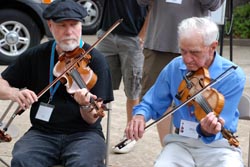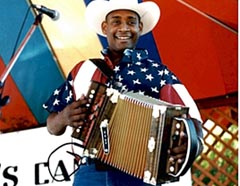Cajun and Zydeco Music Traditions
By Barry J. Ancelet
Cajun music and zydeco are closely related parallel music forms. Cajun music is the music of the white Cajuns of south Louisiana, while zydeco is the music of the black Creoles of the same region. Both share common origins and influences, and there is much overlap in the repertoire and style of each. At the same time, each culture proudly and carefully preserves the identity of its own musical expression.
Cajun music is a blend of the cultural ingredients found in south Louisiana. The colonial French Creoles were singing the same stock of western French folk songs as the Acadians who arrived in Louisiana during the mid-18th century after being exiled from Nova Scotia. Native American Indians contributed a wailing, terraced singing style. Black Creoles contributed new rhythms and a sense of percussion techniques, improvisational singing, and the blues. The Spanish eventually contributed the guitar and a few tunes.
The violin, which was a popular new instrument in France during the 17th century when the French left for the New World, continued to dominate the instrumental tradition until German Jewish merchants on the south Louisiana prairies began importing diatonic accordions from Austria in the early 19th century. Acadian and black Creole musicians alike began experimenting with the accordion and developed techniques which served as a basis for Cajun music and zydeco. Anglo-American immigrants contributed new fiddle tunes and dances (reels, jigs, and hoedowns) while singers translated the English songs into French. By the turn of the 20th century, these diverse ingredients had combined to form what we now call Cajun music.
Commercial recording companies like Decca, Columbia, RCA Victor, and Bluebird began recording regional and ethnic music throughout America in the early part of the 20th century. Since commercial records were made to be sold, they provided a good parameter of popular trends and also gave an imprimatur to the musicians they recorded. In south Louisiana, popular and traditional culture were the same at the turn of the 19th century, but soon enough the recorded musicians began to set the style. Joseph and Cléoma Falcon were fairly well-known in their local community of Rayne, but the release of "Lafayette" in 1928 made them much larger than life. Everyone wanted to hear the Cajun musicians who had made a record. The newly improvised verse they had added to their arrangement of an older traditional tune immediately became a permanent fixture of the developing core repertoire of Cajun music. Musicians such as the Breaux Brothers; the Walker Brothers, Dennis McGee and Sady Courville; Angelas Lejeune and Mayus Lafleur soon joined the Falcons in defining Cajun music style and repertoire on recorded. The early recordings of 1928-34 featured the accordion, fiddle, and guitar, and a high-pitched singing style necessary to pierce through the noise of dance halls.

By the mid-1930s, the Americanization of south Louisiana was well under way, and Cajun music reflected this strain on Cajun culture. Accordions began to fade from the scene as stringbands drifted toward Anglo-American styles, incorporating western swing, country and popular radio tunes into their repertoires. Rural electrification made sound amplification available to country dance halls producing changes in instrumental and singing styles. Traditional Cajun and Creole music was pushed underground by new, more popular sounds. However, Cajun culture and its music resurfaced just after World War II. This was not an intellectual movement, but a visceral one. Musicians like Iry Lejeune, Lawrence Walter, Austin Pitre, and Nathan Abshire responded to the demand from Cajuns who were growing uneasy with the loss of their cultural base. Thus, Cajun music made a dramatic comeback during the 1950s finding its way back into many country dance halls. It did not, however, completely lose it raw, rural nature. The revival was openly regretted by the many urbanized and upwardly-mobile Cajuns who sought to distance themselves from such raucous identity markers. The revival was also immediately threatened by the rock & roll explosion of the mid-1950s. Young Cajun musicians were understandably tempted by the potential for money and fame as they watched fellow Louisianans Jerry Lee Lewis and Fats Domino shoot to the top of the charts.
In the 1960s, traditional Cajun music was in danger of being overwhelmed by the popular commercial sounds of country, rock & roll, and Beatlemania. National organizations such as the New port Folk Foundation, Smithsonian Institution, and the National Folk Festival began to encourage the preservation of traditional Cajun music, sending folklorists and fieldworkers to record the oldest styles and identify the outstanding performers. The tradition was validated with outside audiences as Cajun musicians became a regular feature on the folk festival circuit. Master fiddler Dewey Balfa was determined "to bring home the echo of the standing ovations" he and his Balfa Brothers Band had received in cities across America. He eventually succeeded in convincing local recording companies to release traditional music alongside their more commercial records. He organized a folk-artists-in-the-schools project to introduce Cajun music to Louisiana students. He also helped to organize festivals and special concerts to provide new settings for Cajun musicians and serve young audiences. The results of Balfa's efforts to bridge a cultural generation gap were soon evident. Now, given the choice, many young Cajuns are choosing to play the music of their heritage while still maintaining their contact with the popular American music scene.
Among the first young musicians to experiment with Cajun music were Zachary Richard and an influential group called Coteau. Richard recorded soulful renditions of traditional and original arrangements of Cajun dance tunes for his Bayou de Mysteres band. He also discovered that other parts of the French-speaking world were interested in Louisiana's French music, especially when it was jacked up few notches. Led by Michael Doucet on fiddle, Bessyl Duhon on accordion, and Bruce McDonald on electric guitar, Coteau attracted a substantial young audience with an exciting fusion of traditional Cajun music and southern rock & roll.
Today in 1991, young musicians continue to improvise new sounds and preserve old ones. Zachary Richard has kept his version of Cajun music up to date with contemporary trends including reggae and rap. Michael Doucet and BeauSoliel have added a wide range of influences including classical and jazz to their strongly traditional base. Wayne Toups preserves the spirit of his heroes while developing his own hard-driving ZydeCajun sound. Bruce Daigrepont has produced stylish new songs in a lighter pop-Cajun vein. There is even a heavy metal Cajun group, Mamou, led by Steve Lafleur, which runs traditional waltzes through an electronic maze of synthesizers and wa-wa pedals. Some youngsters, such as Steve Riley and Cory McCauley, deliberately play in the old-time traditional style, but even they innovate new harmonies and arrangements. Even staunch preservationist Dewey Balfa has invested in the future, composing what he calls "brand new old songs."
Cajun music is no longer only a self-conscious choice - it is part of the regular music scene. The tradition is renegotiated and reinvented weekly. One can hear Cajun music in restaurants and on the radio, on television, and at weekend jam sessions. With an active recording industry, festivals and scores of weekly performances, young musicians how have many opportunities to falling love with the music of their heritage, role models to emulate, and plenty of room to experiment.
Zydeco, zarico, zodico, zologo, and even zukey jump represent a few of the spellings used by folklorists, ethnomusicologists, record producers, and filmmakers in their attempts to transcribe the word performers used to describe Louisiana's black French Creole music. The spelling zydeco was the first to appear in print, used by ethnomusicologist MacCormack in the early 1960s. Today it is the most widespread label and most record companies favor it.
Because its language is French or Creole, zydeco tradition has largely remained a mystery to outsiders. Folk spellings and folk etymologist often develop to explain or rationalize words and expressions whose origins or exact meanings have become unclear. Native Louisiana Creoles explain that the word zydeco comes from les haricots after the expression "Les haricots sont pas sale" ("The beans aren't salty"), heard in many of the tradition's songs. However recent studies based on early Louisiana recordings made by Alan and John Lomaz suggests that the term, as well as the tradition, may have African origins. The languages of West African tribes affected by the slave trade provide some clues as to the origins of zydeco. In at least a dozen languages from this culture-area of Africa, the phonemes "za," "re," and "go" are frequently associated with dancing and/or playing music.
In South Louisiana, the meaning of zydeco has expanded (or survived) to refer to dance as a social event and dance styles as well as the music associated with them: Creoles go to a zydeco to dance the zydeco to zydeco music played by zydeco musicians. Used in an expanded way, as a verb, zydeco seems to have other meanings: "Let's zydeco them," or "Let's go zydeco." Community musicians are described as zydeco kings, queens, and princes. Community dance events, which provide the primary opportunity for courtship, are announced as zydecos. The word zydeco also refers to hard times and, by association, to the music that helped to endure them. In black American tradition, this music is called the blues, whether it be a "low-down" blues lament which relieves by purging, or a jumping, juking blues which relieves by distracting. Zydeco's bluesy side is sometimes based on melodies and rhythms of a delta blues tradition. Other times, an interesting confluence of European and Afro-Caribbean rhythms and sources produces haunting songs which function equally well as blues laments and as waltzes.
Amédé Ardoin, the first black Creole musician to record in the late 1920s, figured prominently in the development of zydeco. His highly syncopated accordion style and inspired improvisational singing helped to define the early style. Ardoin's immensely popular regional recordings led the way for subsequent black performers and influenced many Cajun musicians as well - notably Austin Pitre, Iry Lejuene, and later Michael Doucet. What we have come to call zydeco today is the result of the experimentation which occurred during the late 1940s and 1950s. Black Creole musicians combined older musical traditions, which was the unaccompanied black French shouts called jures, with instruments then eventually formed whole bands. The dominant figure in the formation of contemporary zydeco was Clifton Chenier. His genius for combining older black Creole French traditions with rock and rhythm & blues is at the very heart of contemporary zydeco. He also pioneered the use of the piano accordion, giving the tradition access to the full range of the chromatic scale. Other musicians (Sidney Babineaux, Herbert Sam, and Boozoo Chavis) also contributed significantly to the development of the form. Black Creole duos like Delton Broussard and Calvin Carriere or Alphonse "Bois-sec" Ardoin and Canray Fontenot preserve an early pre-zydeco rural black Creole sound. But there is an unmistakable tendency toward soul and rhythm & blues among Louisiana Creole musicians as zydeco drifts toward the English-speaking American market. Over the last few years, second and third generation performers (Alton "Rocking Dopsie" Rubin, Lawrence Ardoin, John Delafosse, Leo Thomas, the Sam Brothers, Stanley "Buckwheat" Dural, Sidney Semien, Lynn August, and Terrance Semien) have pushed zydeco into bold new directions. Yet the same band leaders who insist on singing English lyrics and adding saxophones, trumpets, and electric guitars to their groups will demonstrate their deep understanding of the essential tradition when they play what they call "du vrai zydeco." The "real stuff" is usually characterized by French vocals. The rest of the band drops out while the accordionist and the percussionists beat out a jumping rhythm. The accordion is transformed into a melodic drum, sounding music like an African thumb piano. These irreplaceable elements reveal the style's origins in the cultural creolization of Afro-Caribbean and Franco-American traditions.






